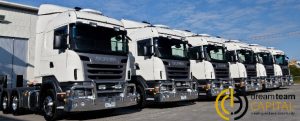A logistics business plan is vital to starting a new, expanding your current, or buying an existing logistics business. South Africa is an important transportation hub with major shipping lines along the coastline. The country is a continental leader in transport and logistical sophistication with first-class roads, the largest rail network in Africa, and eight commercial ports to serve specific hinterlands.
The Logistics Sector
Logistics is a service rendered by sea, air, road, and rail modality with a number of inter-linkages. The industry is rooted in many other sectors, serving as a ‘feeder–network’ to a plethora of industries, especially retail, agriculture, and manufacturing.
The South African Freight and Logistics Market are estimated to witness a CAGR of approximately 4% during the forecast period. Major shifts in transport patterns due to COVID-19 have a major impact on a large part of freight transport in the way they have to organise businesses supported by logistics to keep growing profits.
Regulations were also reviewed to respond to the changes in the sector. In February 2021, the cabinet approved the revised White Paper on National Transport Policy, still to be gazetted, that incorporates changes in the road, rail, maritime, and aviation sectors and aligns the total transport sector to international, regional, and continental transportation trends.
With consumers demanding ever-faster delivery times, and the high costs associated with servicing the last mile, retailers and logistics operators are pushing to improve their distribution models, reduce inefficiencies, and hold stock closer to consumers. This strong occupier demand to hold stock within urban areas is supporting investor sentiment.
In South Africa, requirements for new, modern, and efficient distribution centers remain stable, and demand has outperformed all other asset classes and industrial sub-segments, resulting in an overall income return of 9.2% and capital growth of 0.8% in 2020-2021. A good example of the focus on prime warehousing space has been Takealot’s recent leasing of approximately 11,000 sq. m. of space in Montague Park in Montague Gardens. In February 2022 the Tribunal conditionally approved the merger wherein DP World Logistics FZE (DP World), ultimately owned by the Dubai government, intends to acquire the South African firm Imperial Logistics Limited (Imperial). Following the implementation of the merger, DP World will solely control Imperial.
Key elements of a comprehensive and coherent Logistics Business Plan include:
•Executive summary: This is an overview of your business and plans. It is positioned first in the business plan and is 1 to 2 pages. It includes key information on top management, the amount and purpose for funding or grant requests, mission and vision statement.
•Services offering: This defines a level of service for a price- it combines the service (utility) and a service level target (warranty) to bring value to the client. Each service offering costs a different amount based on the service level targets.
Depending on the business plan and company, the elements below may also be included;
-Warehousing: An integral component that provides support by storing, protecting and delivering goods, along with keeping a stringent check on quality as well. Warehouses play an active role in packaging, labelling, bar coding. The aspects which must be covered in order to have a well-maintained warehouse include safety measures, security measures, pest control, and reporting. Factors that must be considered before opening a warehouse include locality, condition of the site, availability of land, access to labour, and floor condition.
-Courier services: This services comprises delivering important letters or documents with speed, personalisation, customisation, and tracking efficiency.
-Cargo and air cargo services: Deliver materials, goods or different tangible articles locally and internationally.
-Third party logistics: Outsourcing your logistic services to an outside company. The company, to which the outsourcing is done, takes care of the entire supply chain process.
-Inventory management: Keeping a check of any goods or stock kept under supervision in a company, of what goes out and what needs to be replenished.
-Cross-docking: Shifting the materials of an incoming transport to another transport without having to store anything in the warehouse.
•Company and management summary: This section describes the business structure, pointing out the individuals that are involved. It gives vital information regarding the people that are responsible for the management of the company. Job roles and responsibilities are also described.
•Market analysis: A study of the attractiveness and dynamics of the market and industry. It includes a SWOT analysis of the Company and an analysis of the target market; as well as competitive edge and market trends.
•Sales and marketing strategy: Is your plan for reaching, engaging, and converting target prospects into customers.
•Financial projections: Includes documents comprising of the management account, income statement, balance sheet, cash flow, cash forecast, break even analysis, loan amortisation schedule, and fixed asset schedule. Charts, ratios, graphs, and calculations are included.
•Annexes: Includes additional documents to give the reader a feel of your service. Includes management CV’s and ID’s, contractual agreements, and images.
At Dream Team Capital…
We understand the complexities of the requirements and criteria for a detailed and custom business plan. If using the plan to raise funding and/or non-repayable business grants, we guide you through the process and provide access to our funding network. These include venture capital companies, private equity companies, angel investors, banks, Government BBBEE initiatives, Silicon Cape investment organisations, rent to own asset funding companies, crowd funds and more!
For more information & assistance with your Logistics Business Plan do not hesitate to Contact us


